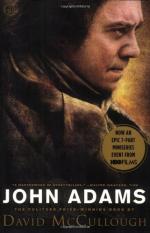|
This section contains 482 words (approx. 2 pages at 400 words per page) |

|
John Adams Summary & Study Guide Description
John Adams Summary & Study Guide includes comprehensive information and analysis to help you understand the book. This study guide contains the following sections:
This detailed literature summary also contains Topics for Discussion and a Free Quiz on John Adams by David McCullough.
John Adams follows the life of the first vice president and second president of the United States, friend and foe of such American luminaries as Benjamin Franklin and Thomas Jefferson.
Late in life, Adams lamented that his rightful place in history would be forgotten, despite the yeoman's job he had done rallying the revolutionary forces at the Continental Congresses in Philadelphia, gaining France as an ally in the struggle, securing bank loans in Holland, negotiating peace with England and representing the new nation before a throne that still hoped the rebellion would fail and used its commercial strength to hasten that end. He had worked long hours, written analytically and fearlessly, traveled great distances and endured unendurable separations from his loving and beloved wife and confidant, Abigail.
Adams wished he could return to the private life of a farmer and earn his living as a lawyer, activities he had sacrificed to the revolutionary cause. He was elected vice president, an inconsequential office under the new Constitution, and served President Washington loyally and conscientiously, only to heap upon his own head calumnies at the hands of increasingly partisan politicians.
John Adams realized that he was Washington's heir apparent. Although Republicans, who opposed strong government and wanted him skipped over in favor of Thomas Jefferson, Adams' great friend who had lately distanced himself and grown aloof, Adams won the first contested election in American history. Because of a quirk in the Constitution, Adams found his opponent seated as vice president.
Adams hoped to bridge the partisan gap but was rebuffed. Opponents distorted his writings to paint him as a monarchist, bent on having his son, John Quincy Adams, succeed him in office thereby subverting the revolution and establishing hereditary rule in America. Nothing could have been further from the truth, but the charge could not be shaken. Adams signed the Alien and Sedition Acts, a clear violation of the First Amendment, aimed at suppressing Republican newspapers, and he was ill-served by a cabinet ruled behind the scenes by Alexander Hamilton, a High Federalist and would-be "Second Napoleon." Adams' greatest goal was to avert war with either France or Britain before the country was strong enough to prevail. This he did, but the peace treaty, which could well have won him reelection in 1800, became known in America too late to help.
Adams retired with Abigail to his farm in Quincy, Massachusetts, and maintained broad correspondence with old friends. One, Benjamin Rush, also a close friend of Jefferson, convinced the two ex-presidents to reconcile their differences. They undertook one of the most remarkable correspondences in American history and, arguably, in the English language.
The two patriots died within hours of one another on the fiftieth anniversary of the Declaration of Independence. David McCullough paints an absorbing portrait of an overlooked man, his remarkable wife and their circle of friends, enemies and family.
Read more from the Study Guide
|
This section contains 482 words (approx. 2 pages at 400 words per page) |

|



